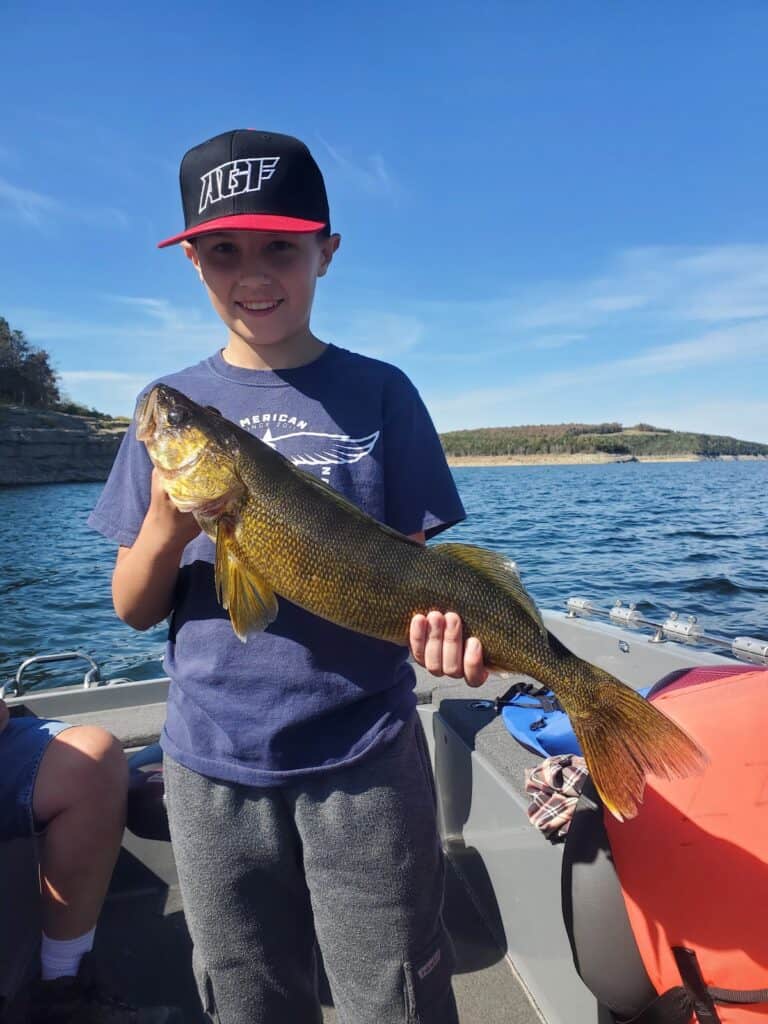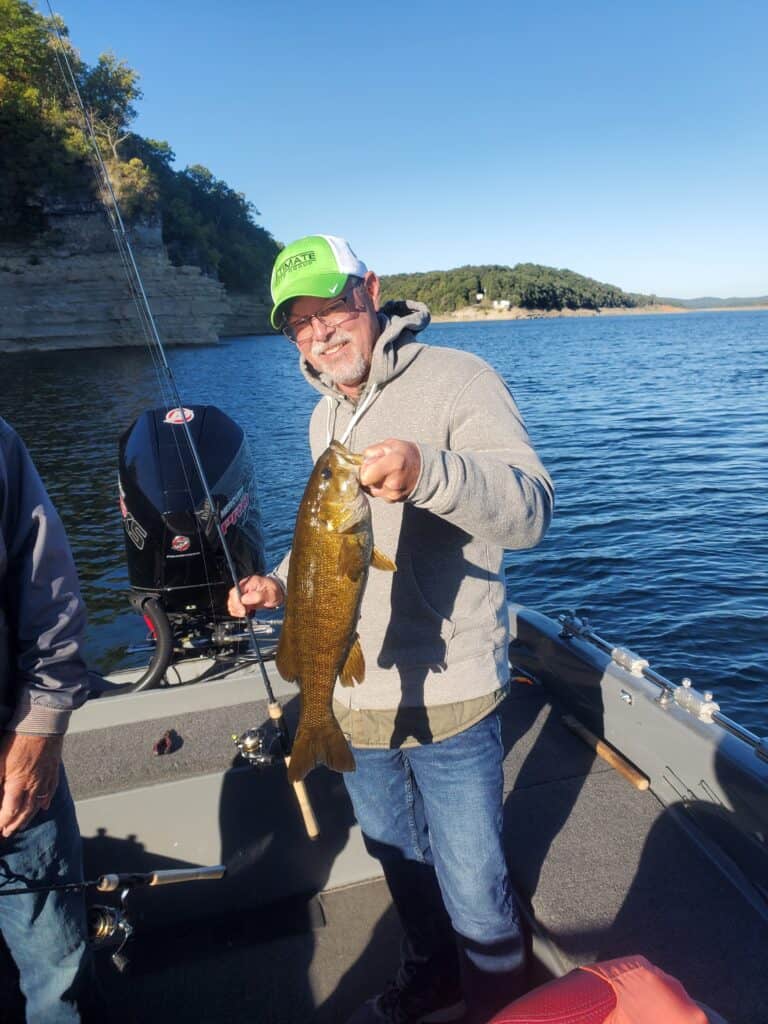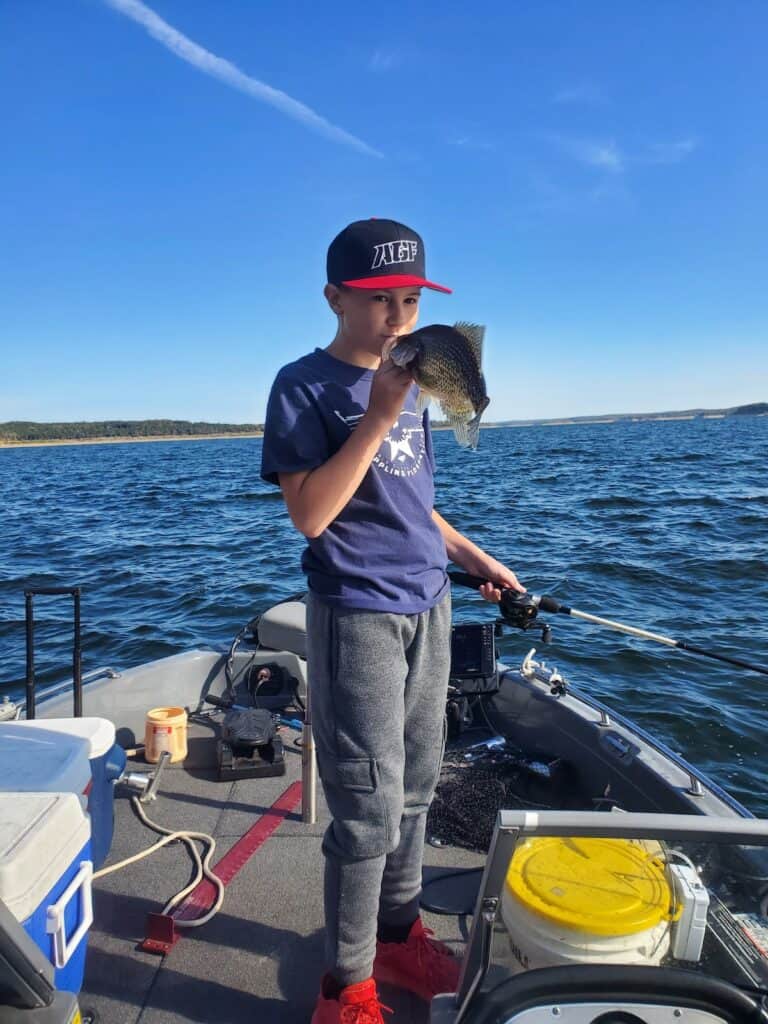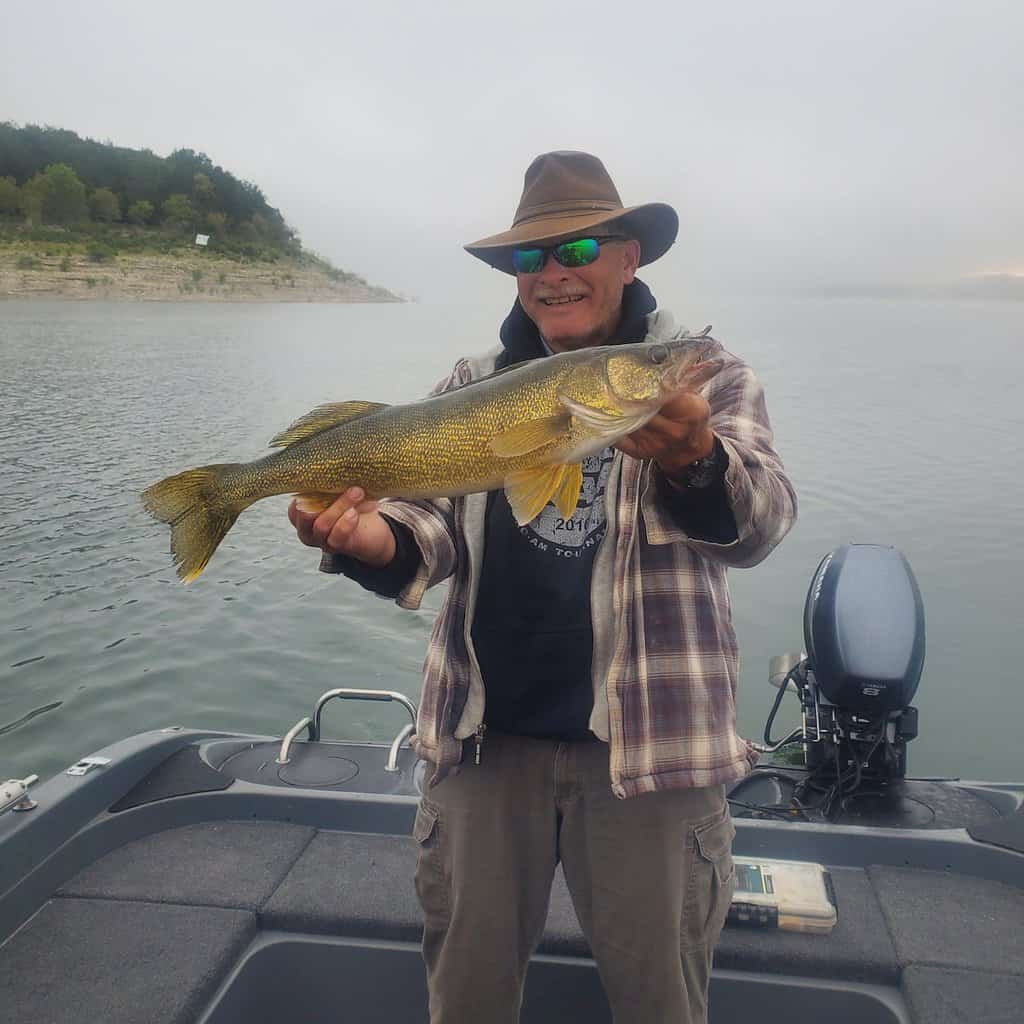The fishing at Bull Shoals Lake is world-class, thanks to the number of species and accessibility across over 71,000 acres and more than 1,000 miles of shoreline.
This crystal clear reservoir sprawls along the Arkansas-Missouri border, although most of the water is in northern Arkansas.
Whether pursuing bass, walleye, or anything in-between, you will find success fishing Bull Shoals Lake, especially if you have some experience or knowledge going in.
So, in the rest of this article, you’ll discover some of the best tips and tactics to catch your favorite species, including where you should start, what baits and lures to use, and what time of year is best.
Let’s get started with the bug-eyed fan favorite, walleye.
Bull Shoals Walleye Fishing

While walleye are not the hardest-fighting fish, most of the time. Honestly, I’ve caught some that feel like a stick while reeling them in.
However, they’re one of my favorites to catch because they’re so tasty. And they also are a real challenge to catch, especially in water as clear as Bull Shoals.
You might also catch sauger at Bull Shoals. These are close relatives of the walleye. Sauger tend to run a bit smaller, but they will fall for the same tactics and also are delicious. Just figure if you’re fishing for walleye here, you might also hook this cousin.
To give us the biggest advantage we can get while walleye fishing, we need to understand the spawning cycle of walleye to know where we should be fishing when we visit the lake.
Let’s begin our search in early spring. Walleye spawn earlier than most fish, typically in March or early April at Bull Shoals. At this time of year, the best place to start is rocky shorelines, as they spawn along shallow rocks.
Fishing near the dam is usually good for walleye and sauger in early spring. Rocky points or flats are also favorite spots.
Some of the best lures are jigs and Rattlin’ Rogue crankbaits, and live bait anglers should score with nightcrawlers and minnows.
After spawning, walleye move to deeper water, generally around rocks and underwater humps. They’ll patrol these areas near the bottom for the rest of the year.
When fishing for deeper-water walleyes, it’s best to troll with deep-diving crankbaits or bottom bouncers with worms or minnows. Keep those offerings near the thermocline (often 10-15 feet deep), as this is the depth most walleye prefer.
I’ve also found it best to fish for walleye before sunrise or after sunset because their large eyes are very light-sensitive, so they tend to have a nocturnal feeding pattern.
My favorite colors for walleye in clear water are natural and translucent, with a touch of chartreuse or bright pink.
Bass Fishing
Black bass are one of the biggest draws to Bull Shoals because they grow to be true giants, and there are loads of quality-sized bass. So you won’t only be searching for that one big bite.
Three black bass species call Bull Shoals Lake home: largemouth, spotted bass, and smallmouth bass. The lake has staked claims to state records for the latter two.
All three share a similar spawning pattern but have drastically different preferences, so we’ll break them up by species when talking about their differences.
Bass spawn at Bull Shoals in the spring, generally in April or May. They find shallow rocky areas to make nests. They prefer pea gravel over boulders and mud.
Largemouth and smallmouth bass will spawn ultra-shallow, while spotted bass will stay a little deeper.
During the spawn, I use bluegill and crawdad-colored lures since these are bass’s two biggest enemies this time of year.
Once the spawn is over, bass will disperse and head to cooler, deeper water to spend most of the year.
Rocky points and channel swings, both in the main lake and its major arms, are the most common places bass hang out for much of the year. Sometimes you’ll find them as deep as 40 feet.
Largemouth Bass
Head for one of the many creek branches on Bull Shoals when targeting largemouth bass.
Largies are generally the bass you’ll catch in the shallows most times of the year.
Largemouths are most inclined to ambush prey from behind logs, grass, and rocks. This is why using crankbaits, jigs, spinnerbaits, and soft plastics in 15 feet or less of water will usually lead to a bite from a largemouth.
Since the water is super clear, natural and translucent colors are my go-to. It’s tough to beat green pumpkin and shad colors.
Largemouth are the biggest of the three species and can get over 10 pounds at Bull Shoals, but most will be in the 2-3-pound range.
Spotted Bass
Spots are often found on the main lake points and in creek mouths after spawning. They are much better suited for open water than their cousins, and their primary food source is shad.
This means silver and chrome are the best colors to use for spotted bass.
I’ll throw a crankbait, spinnerbait, or hair jig to target spots. A white swim jig, soft plastics, and swim baits are also great lures.
I’ll downsize my lures just a bit when trying to catch spotted bass because they don’t get as big as largemouth.
Smallmouth Bass

Smallies are my favorite bass to catch because they’re aggressive and fight hard.
They primarily inhabit the in-between areas of largemouth and spotted bass. Most smallmouth I catch are holding on humps and rock piles in 10-20 feet of water.
I also catch a lot in the rivers feeding into a reservoir because smallmouths are adapted to more current than the other species.
I also downsize my lures for smallmouth. My favorite lure to catch them on is a Mepps spinner, but I also catch a ton on a wacky-rigged green pumpkin plastic worm.
Any lure resembling a crawfish or small baitfish will usually work.
I like experimenting with the same colors for smallmouth lures as spotted and largemouth bass. Natural colors are generally best in clear water, no matter the species.
Catch More Bass
Crappie Fishing

Crappie are another table-fare favorite of mine. They’re a blast to catch on ultra-light gear, which will be best for Bull Shoals since the water is so clear.
There are two species of crappie in the lake, black and white crappie. Though they have slightly different preferences for water conditions, you’ll catch them side-by-side using the same lure most of the time.
Black crappie prefer clean, clear water, while white crappie tolerate stained water better. Since water clarity is rarely an issue at Bull Shoals, you’ll find both species scattered around the lake although black crappie are most common.
The spring is the best chance to catch crappie from the shore as they spawn in shallow water along rocky and wooded banks. Natural-colored jigs and live minnows work the best this time of year.
As the water heats up, crappie move to brush piles in the 15- to 25-foot range.
Over 170 brush piles were placed on the Missouri side of the lake by the Missouri Department of Conservation. If you’d like the exact locations of the lake’s brush piles, download the MO Fishing App or get the coordinates on your sonar unit from MDC’s MO Fishing Interactive Map.
On the Arkansas side, submerged fish attractor areas such as old Christmas trees are marked with signs along the shoreline.
During the summer, slowly trolling crankbaits over brush piles can help you locate an active school of crappie. I like to stick with natural colors but add chartreuse or bright pink to help stand out from other anglers.
In the fall, crappie will follow baitfish shallow and feed heavily before returning to deeper waters for the winter.
Crappies primarily stick to deep water in the winter, and minnows are the best bait to catch them. But on warm days, you can find schools of crappie patrolling shallow flats in the backs of creeks.
Catfishing
Another favorite of anglers who love to fill their freezers with fillets is the ole slimy catfish.
Blue cats and channel cats are the two primary species in the lake. There are flatheads here as well, but the bass fishing vastly overshadows the catfishing.
All three species spawn in late spring or early summer, typically in May or June at Bull Shoals. However, unlike most other fish species, this is one of the most challenging times of the year to catch them. You can try fishing along rocky banks with lots of access to deep water, where catfish spawn.
The rest of the year, it’s best to find a depth change, especially a hole or channel ledge, and fish that. You’ll find catfish moving up onto flats to feed in the evening and at night.
There are a few different ways to catch catfish, from trotlines, jugs, limb lines, and rod & reel. However, depending on where you are on the lake, not all methods are allowed, so be sure to check the regulations for the area you plan to fish.
They might have similar life patterns, but you can adjust a few things in your approach to target one species over the other.
Flathead Catfish
You’ll catch flatheads in the same areas using the same baits as you will blues and channel cats. However, using live bluegill tends to weed out the channel cats, and fishing around brush piles, even in the shallows, and at creek mouths.
The shallower water usually limits number of blues you’ll catch, while larger live baits will be too much for the channel catfish.
While you might catch a catfish of a lifetime, don’t expect fast action targeting flatheads. Since they aren’t as common in Bull Shoals as channels and blues, so I treat them as a bonus fish.
Blue Catfish
Blues are the largest catfish in North America and grow to well over 100 pounds in ideal habitats. The large size of Bull Shoals means the blue catfish have plenty of space to roam and find their next meal.
They’re not picky eaters, generally eating anything from nightcrawlers to cut bait to chicken liver.
I recommend using heavy-duty fishing gear, as you never know when you’ll hook a monster.
Blue catfish will often hold in some of the deepest areas compared to other catfish species.
Channel Catfish
Channel catfish are the species you’re most likely to catch, and if you’re looking for quantities of ideal eating-sized catfish, they make an excellent fish fry.
Since channel cats are the smallest of the three species, it’s best to downsize your hooks and baits. I’ve had the best luck with small chunks of cut bait and nightcrawlers on a 5/0 or 6/0 hook for channel cats.
Tailwater Trout Fishing
Trout fishing is another massive draw to Bull Shoals … well, anglers fish the White River, which is the main in-flow and out-flow of the reservoir near the community of Bull Shoals, Arkansas.
A nearby fish hatchery keeps the White River below the dam stocked with primarily rainbow trout, and the river is known for brown trout that are absolute tanks. Even brook and cutthroat trout have also been planted and caught here through the years.
Fly fishing is a popular way to catch trout here.
Midge patterns are the best year-round fly, caddis flies work best in late March and April, and mayfly nymph imitations work well in May and June.
Lures that imitate shad or other smaller fish and fishing live bait can be other excellent options. Be sure to read up on the rules.
Target slow-moving deep pools with current breaks before and after ripples.
A current break can be a rock, stick, or bend in the river that diverts the water. Trout will sit behind current breaks waiting for their next meal to float by, so it’s best to fish these structures and areas.
Other Bull Shoals Gamefish
White & Hybrid Bass
White bass, or sand bass, as I often call them, might be the most underrated fish in America. They’re hard-fighting, fast-action, and decent eating, so what’s not to love about them?
Hybrids are often found in the same schools as white bass, so we will also throw them into the mix.
I catch them one of two ways; I’ll cast or troll. Both are very effective depending on the time of year.
In the spring, white bass and hybrids head up the creeks to spawn in shallow rocky areas. I’ll cast crappie jigs, spinners, and small crankbaits for them this time of year.
Once spawned, sandies return to the creek and river channels to patrol the open waters. After the spawn, and typically through the summer, I begin trolling the main lake using crankbaits and spoons.
Once you’ve found a school, don’t be afraid to stop and start casting or trolling back through that spot to catch more.
There’s nothing more fun than watching white bass explode on a topwater once you’ve found them! Even if they’re 10-plus feet deep, don’t be afraid to throw a topwater lure if the conditions are right.
Catch More White Bass
We’ve pinpointed Missouri’s best white bass fishing destinations in one handy guide. Oh, and we have the best white bass fishing in Arkansas in another article.
I compiled my favorite methods to catch white bass (sand bass) in this complete fishing guide. It should serve you well for hybrid bass as well.
Striped Bass
To say that Bull Shoals has some of the best striped bass fishing in the world isn’t an overstatement. A world record-sized striper was caught here in recent years. However, striper fishing still isn’t as popular here as you might think.
They have a similar spawning pattern but targeting stripers is a little different than their cousins, the white bass and hybrids, because they grow much larger.
Stripers will form separate schools and spend most of their time in the open water, occasionally coming shallow to feed.
Striped bass primarily feed on large shad and other baitfish. Live bait is the best way to catch them but lures that resemble these fish also work well.
Fishing for stripers is often a mix of bass and catfishing because you’re initially searching for them by trolling or casting, and once you’ve found them, you’ll drop your live baits down and wait for a bite.
More: , Read our guide to freshwater striper fishing (lakes and rivers) for more tips.
Bluegill and Sunfish
Panfish are the best fish to introduce someone to fishing, including kids, because they’re easy to catch and virtually everywhere around the lake.
Bluegills are one of the most common species in the lake, and also among the easiest to catch while shore fishing at Bull Shoals.
Worms work best to catch most types of sunfish, but I’ve also had lots of luck using crappie jigs.
All you have to do is find a fishy shallow area and drop your bait in. Using a bobber, I like to keep it about six inches off the bottom. If the fish are there, you should get an immediate bite.
If you aren’t getting quick hits, keep moving down the bank to good-looking spots, switching up the type of habitat, depth and lures or bait until you find the winning combination.
Brush, rock, and grass are the best places because they can easily hide from predators like bass and birds.
Because panfish don’t get very big, but fight hard for their size, I recommend using ultra-light gear to make the fishing even more exciting.
Panfish is a general term, but most people mean sunfish, such as the bluegill or perhaps longear sunfish and warmouth (goggle-eye) you might catch at Bull Shoals.
Catch More Bluegill and Sunfish
While these fish aren’t hard to catch, pick up a few more bluegill and sunfish fishing tips to pick the right bait, lures, tackle, and tactics to improve your success.
Paddlefish
These prehistoric fish, also commonly called spoonbills, aren’t at all common in Bull Shoals Lake.
Tagged specimens, though rarely encountered in Bull Shoals, suggest they are washed down from Table Rock Lake.
Planning Your Trip
While fishing is the main attraction to Bull Shoals Lake, there are a few other things you should know before heading to the water, such as where some boat ramps and public access areas are and the best places to stay during your visit.
Boat Ramps & Public Access Areas
Due to its vast size, Bull Shoals has too many boat ramps and public access areas to list them all. However, no matter where you are on the lake, there’s likely a marina, boat ramp, or public access within several miles.
Since the U.S. Army Corps of Engineers manages the lake, much of the land surrounding the lake is public; it’s just not easily accessible to anglers, which is why I recommend sticking to the public use areas if you don’t have a boat.
The Corps notes that many boat launches are free, including access spots they list as HWY K, Welcome Ridge, Bull Shoals, CR 15, Spring Creek, Fairview, and CCC.
Private marinas and resorts around Bull Shoals may also charge a fee for services that may include launching, mooring and boat rentals.
Places to Stay
Whether you want to stay at a campground like Bull Shoals State Park, or a resort near the water, you’ll have many options in both Arkansas and Missouri.
Here’s a list of Corps of Engineers campgrounds on Bull Shoals Lake.
There are several other public or private spots to camp, as well as a variety of hotels and other types of overnight accommodations stretching from the Branson area in Missouri down to the city of Bull Shoals near the dam.
Bait, tackle, and other supplies also are available in many locations.

